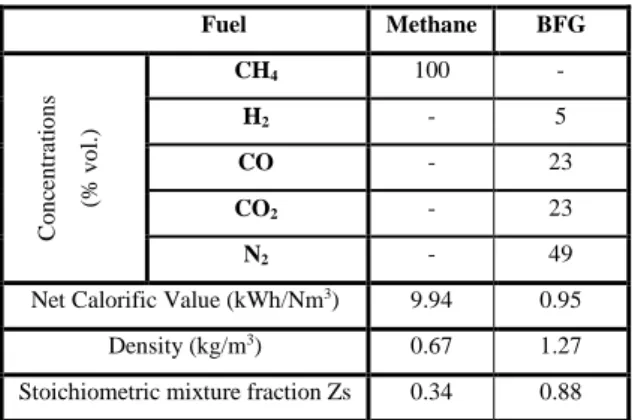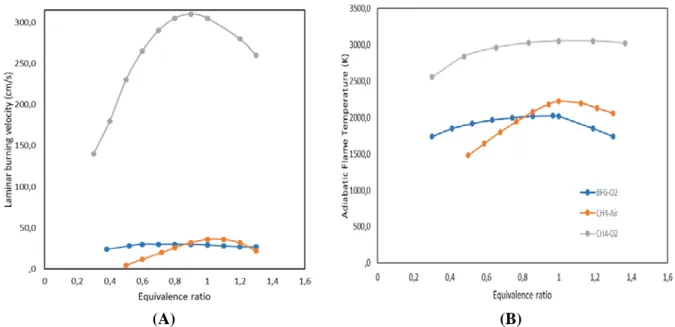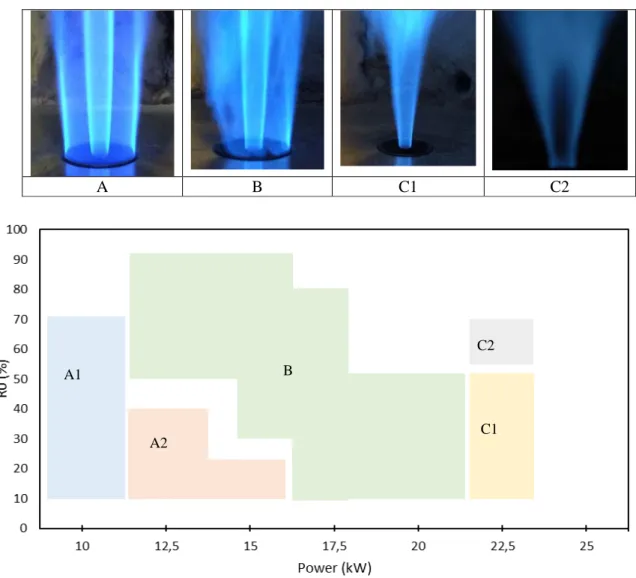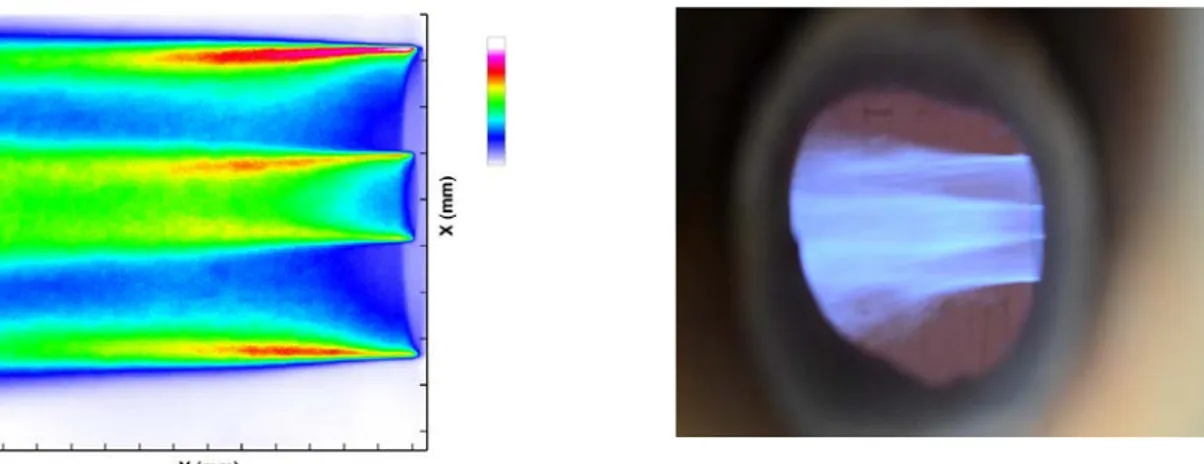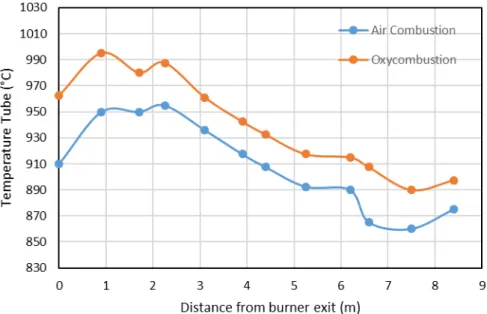HAL Id: hal-02177393
https://hal.archives-ouvertes.fr/hal-02177393
Submitted on 8 Jul 2019HAL is a multi-disciplinary open access archive for the deposit and dissemination of sci-entific research documents, whether they are pub-lished or not. The documents may come from teaching and research institutions in France or abroad, or from public or private research centers.
L’archive ouverte pluridisciplinaire HAL, est destinée au dépôt et à la diffusion de documents scientifiques de niveau recherche, publiés ou non, émanant des établissements d’enseignement et de recherche français ou étrangers, des laboratoires publics ou privés.
Oxycombustion with preheated reactants for low
calorific value fuels: A solution to improve flame
stability and energy efficiency
Niomar Marcano, Abou Bâ, A. Cessou, David Honoré, G Cassarino, L.
Ferrand
To cite this version:
Niomar Marcano, Abou Bâ, A. Cessou, David Honoré, G Cassarino, et al.. Oxycombustion with preheated reactants for low calorific value fuels: A solution to improve flame stability and energy efficiency. 29 Deustcher Flammentag, Sep 2019, Bochum, Germany. �hal-02177393�
1
29. Deutscher Flammentag Bochum, 17-18 September 2019
Oxycombustion with preheated reactants for low
calorific value fuels: A solution to improve flame
stability and energy efficiency
N. Marcano
1*, A. Ba
2, A. Cessou
2,
D. Honoré
2, G. Cassarino
3,
L. Ferrand
3*Niomar.Marcano@airliquide.com
1 Air Liquide Research & Development, Paris Innovation Campus, 78354 Les Loges en Josas, France
2 Normandie Univ, INSA Rouen, UNIROUEN, CNRS, CORIA, 76000 Rouen, France
3CMI GreenLine Europe, 78280 Guyancourt, France
Abstract
In the global energy scenario, the demand will continue to grow by around a third by 2040, with the industrial sector accounting for around half of the overall increase, particularly for energy-intensive industrial sectors, such as steel and cement. Carbon emissions also will continue to rise, signaling the need for a comprehensive set of actions to develop, commercialize and adopt emerging energy-efficiency and CO2 emissions-reduction technologies.
The Low Calorific Value (LCV) fuels generated in any industrial processes are today widely seen as a potential energy source. In steelmaking process, LCV fuels with CO/H2/CH4/CO2/N2 mixtures are
typically used using air and blended either with natural gas or with a gas with higher calorific value such as the coke oven gas (COG). Having air to burn this type of gas limits the thermal efficiency due to the amount of heat wasted in the nitrogen, can provide high NOx emissions and, is not an economical viable alternative for Carbon Capture Use and Storage (CCUS) solution in the light of the very low concentration of CO2 in the flue gases. In addition to this and compare to typical natural gas,
their use has several issues due to different combustion characteristics, such as flame velocity, adiabatic temperature, and flammability limits, which significantly influence their performance as fuel. Therefore, in order to guarantee the flame stability and allow a reliable operation, using LCV fuel without blending with any fuel with higher calorific value, the present work proposes the combination of technologies, such as oxycombustion and preheating of the reactants. This will also satisfy the actual need for increasing energy efficiency reducing the environmental impact in terms of pollutant emissions such as CO2 and NOx.
Three different combined tasks at different scales were carried out. At laboratory scale, CORIA developed the understanding for preheated LCV/O2 combustion process using thermochemical
calculations. This, together with a critical Damkohler number allowed calculating burner dimensions. The detailed flame characteristics were investigated through experimental tests using imaging OH* chemiluminescence imaging. Semi-industrial pilot scale were also performed at Air Liquide PIC, with the burner scaled up to 180 kW using the constant velocity and the geometrical similarity criteria. These tests were run applying similar operational conditions as laboratory scale. Finally, CMI used engineering simulation tools to evaluate the feasibility of this technology in radiant tube burners considering heat transfer, the presence of hot spots and flame length, as well as, potential CO2
emissions.
The results show that significant enhancement of oxyfuel flame properties can be obtained thanks to the preheating of the fuel and oxygen. The analysis of flame stability diagrams as function of reactant velocities, thermal power, oxygen distribution and preheating temperatures points out the limits of flame stability and the stable combustion regimes achieved at the different operational conditions. Further analysis of the results shows that a critical convection velocity in the fuel – oxygen mixing layer, controls transitions between the various types of flames. This is quantified from the measurements, and matches with the theoretical prediction. At pilot scale, the flames show similar structures as obtained at laboratory scale, validating the physical phenomena that controls the limit of
2
oxyfuel flames stability and, demonstrating the benefit of preheated reactants and oxyfuel combustion in the stabilization of LCV flames. Regarding the emissions, very low levels of pollutant emissions such as CO and NOx are achieved in most cases, depending on the oxygen distribution. Particularly NOx reached limits up to 32 mg/MJ at 3% excess oxygen, which is much lower than typical values of 100 mg/MJ from air-natural gas burners, showing a very high potential to reach the standards levels of NOx required for environmental regulations.
Simulations for reheating furnaces having a comparison between air and oxycombustion with preheated reactants show an efficiency increment of 8 points. For CO2 emissions, calculations for a
particular case of a reheating furnace producing 50000 Ton/year of steel coil, the CO2 avoided is up to
62% due to the efficient use of the energy sources available, which includes avoiding flaring the blast furnace gas (BFG).
Introduction
Low quality fuels such as Blast furnace Gas (BFG), Coke Oven Gas (COG), biogas, syngas and others had been burned with air for quite a long time, but with very low efficiency, strong impact on flame stability and pollutant emissions. The BFG has one of the lowest calorific value within the alternative fuel gases, due to the large concentration of inert gases on its composition and, it is known to be one of the most difficult by-product fuels to provide stable flame and safe combustion [1-3]. In practical applications, BFG is usually burn with supported fuel such as natural gas [4], or coke oven gas [5]. This alternative fuel gas, still in excess in an integrated steel making plant, has also limited use due to restrictions to obtain sufficiently high temperature to reach the target for the process using air-combustion. Therefore, a lot of this gas is normally flared. This operation suggests a high level of wasted energy, and at the same time, high levels of CO2 emissions. Both cases are going against the
limitations for CO2 emissions, which cannot be more than around 1000 Gt of CO2 from 2014 onwards
to comply with temperature increments of up to 2°C [6].
Recent work done by Air Liquide/CORIA [7], and Niska et al [8] showed that oxy-combustion increases the combustion efficiency of COG and BFG for application in reheating furnaces and, at the same time meets environmental limits for NOx emissions (10 mg/MJ). However, the technologies available still faces stability flame issues that are prevented by using booster fuels such as natural gas or COG. As a consequence, developing a technology that allow burning BFG without blending with COG or natural gas is of primary importance to increase its use in a reliable and efficient way, having at the same time an impact on the CO2 emissions.
From the energy saving point of view, recovering flue gases energy to preheat the air is a well-known technology that has been used particularly in the glass and syngas production industries, taking advantage of the flue gases high temperature in these processes. Using heated reactants is a convenient way to increase the global energy efficiency of the plant, and to improve flame stability. Such type of systems has been recently developed by Air Liquide for application in glass melting furnaces using pure oxygen preheated [9]. CFD simulations showed that preheating both fuel and air would be suitable to enhance BFG combustion, increasing the temperature and promoting the CO burnout, without any addition of high calorific value gases [10].
Combining oxycombustion with preheating reactants is an alternative which has not been tested before and which seems to be appropriated for application with the BFG, in the light of its availability and utilization in the steel manufacturing industry. This industry is among the most energy-intensive industries and accounts for the largest share, approximately 27 %, of global CO2 emissions from the
manufacturing sector. The ongoing increase in world steel demand means that this industry’s energy use and CO2 emissions will continue to grow, so there is significant incentive to develop,
commercialize and adopt emerging energy-efficiency and CO2 emissions-reduction technologies for
steel production. The used of BFG, as an independent source of energy, without blending with either natural gas or COG, can be an alternative to increase the process energy efficiency reducing the boosting fuel consumption, and the CO2 emissions. This solution proposed, will provide an integrated
approach for energy-intensive industries, having on one side improvements in the energy efficiency, and on the other side, potential benefits of using CCS technologies, having in mind the high CO2
3 Technical approach and Methods
The technical approach included thermochemical calculations of oxyfuel BFG flames performed at several reactants initial temperatures to quantify the potential benefits and stability of a BFG-O2
diffusion flame, and to provide insight into the burner design. A burner at 25 kW was designed and tested at laboratory scale. This activity followed up by the burner scale up at 180 kW, which corresponds to semi-industrial scale. The tests were carried out at similar operational conditions in both cases, in order to validate the design and scale-up criteria. Finally, the application to several cases in the steel making plants was evaluated through calculations with commercial and self-developed software to provide potential energy efficiency and impact on CO2 emissions.
Flame properties calculations
Table 1 compares BFG compositions and characteristics with Methane. BFG is characterized by its high concentration of inert species (N2, CO2), and a very low H2 content. It has also very low calorific
value corresponding to one-tenth the one of methane. These characteristics lead to have very low laminar burning velocities, SL calculated at 300 K and atmospheric pressure using COSILAB
software, as it is shown in Figure 1, together with the adiabatic temperature as a function of the equivalence ratio. Laminar velocity, SL, for BFG is not high and almost constant over the equivalence
ratio range calculated. For CH4, such large laminar burning velocity of several meters per second - as
for CH4-O2 flame - ensures the strength and stabilization of these oxyfuel flames thanks to the use of
pure oxygen as oxidiser. Low adiabatic temperature for BFG with Oxygen shows a potential limitation to reach process temperature using only the available energy.
Table 1. Compositions and main properties of BFG compared to methane
Fuel Methane BFG C o n ce n tr at io n s (% v o l. ) CH4 100 - H2 - 5 CO - 23 CO2 - 23 N2 - 49
Net Calorific Value (kWh/Nm3) 9.94 0.95
Density (kg/m3) 0.67 1.27
Stoichiometric mixture fraction Zs 0.34 0.88
The adiabatic flame temperature increases quasi linearly with the temperature, as well as the laminar burning velocity, which becomes nine times higher when the temperature of the reactants varies from 300 to 850 K. This is typically described by a power law expression such as:
(1)
High values of SL reached with reactants preheating provide a potential to ensure the oxyfuel flame
stabilization, even for very low calorific value fuel gas. SL increases almost one order of magnitude,
when the adiabatic temperature change is moderate. Thus, a significant flame stabilization enhancement can be achieved without having a strong impact on the thermal process of an industrial facility.
4
(A) (B)
Figure 1. Laminar burning velocity SL (A) and adiabatic temperature (B) vs. equivalence ratio at
ambient temperature for BFG and CH4 flames.
The flame thickness δth and strain rateare another important properties used to evaluate the flame
stabilization. Impact of the preheating reactant temperature on these parameters are showed in Figure 2 [11]. Without preheating, the BFG-O2 flame thickness is around 0,5 mm. When the temperature of the reactants increases, a slightly decrease is observed. Regarding the strain rate, critical numbers, K*, allows to determine where the flame is blow off, such as it’s shown in the Figure 2, considering 4 different preheating reactants temperature.
Figure 2. Laminar burning velocity SL, flame thickness δth , adiabatic flame temperature and critical
strain rate with reactant preheating temperature (Tpr) [11]
At ambient temperature, the adiabatic temperature reaches 1077 K at the limit where the flame is extinguished at K* = 500 s-1, even using oxygen as oxidiser. The critical strain rate at T
pr = 500 K is
twice the ambient case (K* = 500 s-1), and more than three times for T
pr = 900 K. Thus, the preheating
of the fuel and the oxygen has two beneficial effects, the adiabatic temperature is largely increased, but also the preheating induces a significant shift of the maximum of strain rate. All these calculations show the potential benefit of reactants preheating on oxyfuel BFG flame, in terms of flame stabilization and limits to extinguishment.
Oxyfuel burner
The burner configuration included an outer oxidant (O2e), an intermediate BFG section and an inner
oxidant (O2i) coaxially arranged, according to a design previously tested by Paubel et al.[7]. For that
work, the Damköhler number was used as a criterion to design the burner considering that this dimensionless number provides the limit of extinction of a diffusion flame, depending on the type of
5
fuel, when this number reaches a critical value. This number is defined as the ratio between a mixing time , and a chemical time according to equations 2 and 3 respectively [11,12]. The chemical time is determined from thermochemical calculations of the diffusivity D, the stoichiometric mixture fraction Zs and the laminar burning velocity SL. The mixing time depends on the lip width and the convection velocity Uc such as equation 4.
(2) (3) (4) This approach was also adopted to design the burner for this work, in order to guarantee the flame attachment to the burner lip е as a criterion of flame stability. The oxygen distribution between the central and external flows is quantified by a non-dimensional parameter Ro according to equation 5, where QO2i and QO2e correspond to the internal and external oxygen volumetric flowrates. For lab-scale
experiments, the burner is designed for a thermal power of 25 kW with an equivalence ratio of ϕ = 0.96. The same burner geometry is also considered for the semi-industrial scale experiments at nominal power of 180 kW. This corresponds to the thermal power target for reheating furnaces in the steel making industry application.
(5)
Experimental Work
The burner at 25 kW is fitted in a cylindrical combustion chamber with refractory walls, on the lab scale facility at CORIA laboratory. This burner, scaled up at 180 kW using the geometrical similarity and constant velocity criteria, is installed in a horizontal cylindrical combustion chamber at Air Liquide Paris Innovation Campus. In both experimental cases, the synthetic BFG mixture is provided by a dynamic mixing system of pure gases, controlled by a set of mass flow meters, having special safety measures due to the use of toxic gas as Carbon Monoxide (CO), and extremely flammable gas such as Hydrogen (H2). Electric heating systems were used to control the preheating of the fuel
mixture and the oxygen. The main criteria to evaluate burner performance included flame characteristics, emissions of O2, CO, CO2 and NOx in the flue gases, as well as the temperature
profile. The two installations are equipped with sampling ports and facilities to carry out these analysis using different techniques. Particularly, the flame structure was evaluated by OH* chemiluminescence imaging and photos of the flame root taken with an endoscope for the 180 kW tests.
Laboratory scale results
The flame stability diagram without reactants preheating, presented in Figure 3, shows the limits of the different flame types depending on the oxygen distribution Ro and power. Outside of these limits, the flame is blown-off particularly at Ro lower than 10% and power at 25 kW for all the range of Ro. This figure also displays the flame photos corresponding to the different types. Flames types A1 and A2 are very stable and show a structure of double concentric flames, attached to the burner lips, and with higher and lower CO concentration for the A1 and A2 types respectively. For A2, larger flowrates enhance turbulence mixing and ensure complete combustion. Type B flames present local fluctuations in the external BFG-O2e flame, which generates an averaged dissymmetry on this external flame. This effect becomes more pronounced when increasing either the power or the oxygen distribution, Ro, leading to the C1 type flame. For this, the external flame is lifted-off and the attached central BFG-O2i flame is very stable. Finally, for the highest power and Ro, local extinction is observed in the central flame, type C2, before it is completely blown-out.
6
A B C1 C2
Figure 3. Stability diagram of BFG-O2 flames without reactants preheating
With the reactants preheating at power from 20 to 25 kW, shown in Figure 4, the range of flame stability is extended from 15 kW, as the case without reactants preheating, up to 25 kW. In this case, another double attached flame can be defined as A3. For this, the large momentum flux in the central oxygen lifted-off the BFG-O2i flame, whereas the external BFG-O2e flame is kept attached to the
burner. Increasing the power, the outer BFG-O2e flame is still attached to the burner, even at higher
momentum of the inner jet, having the D type structure. In this case, the highly stable external BFG-O2e flame acts as a protective pilot flame supplying sufficient heat to ensure the ignition of the internal
BFG-O2i flame downstream.
The structure of the different flame types by OH* chemiluminescence is observed in Figure 5. These images confirm the flame type classification based on the high intensity reaction zones, either in the internal or external flames, as well as on the fluctuations of any one of these flames based on changes in the power or in the oxygen distribution.
A1
A2
B
C1 C2
7
Figure 4. Stability diagram of BFG-O2 flames with reactants preheating at 600 K.
A B C1 C2 D
Figure 5. Structures of the different BFG-O2 flames obtained by averaged OH*
chemiluminescence image [11] Pilot scale results
Tests within the burner turndown ratio between 100 kW and 180 kW were carried out during the semi-industrial experiments. In the whole range of burner capacity and oxygen distributions, the flames were stable, attached to the burner exit, and classified as type A2. For operating conditions corresponding to 180 kW, with Ro of 85%, BFG and oxygen preheated to 700K and 550K respectively, the OH* chemiluminescence imaging carried out through the first optical access to the burner exit, showed the same flame structure as the one observed in the laboratory scale tests. This result is presented in Figure 6.
A3
A2
8
Figure 6. Oxyfuel BFG flame obtained at Air Liquide Paris Innovation Campus Left: Mean OH* chemiluminescence image. Right: Flame photo.
The emissions at different oxygen distribution and 3% excess oxygen are presented in the Table 2. The NOx levels reached on these tests at 180 kW are between 32 and 23 mg/MJ, which are much lower than the limit of 100 mg/MJ. This limit was reached in a reheating furnace, with a traditional air burner where air is preheated at 520°C [13].
Table 2. Emissions at 180 kW and 3% excess oxygen Emission Oxygen Distribution Ro (%)
15% 30% 50% 80%
CO (ppm) 284 302 435 94
NOx (ppm) 52 60 66 50
CO2 (%) 42 41 41 40
Application in reheating or heat treating furnaces with environmental impact
Several cases were used to evaluate the impact of this technology on processes related to the steel making industry. BFG oxycombustion with preheated reactants was compared to typical air case.
Continuous galvanization lines: simulations of a radiant tube burner at a nominal power of 180 kW, were carried out by CMI using Ansys-Fluent code, and a self-developed code. For this simulation, the comparative case included a gas mixed with air. The main constraints included the maximum temperature to reach in the tube that should be 950°C, and the temperature of the flue gases that should be high enough to preheat the oxygen and the BFG. For the oxycombustion case, the results showed in Figure 7 display an increment in the tube temperature between 20 and 55°C, with the maximum situated at 1.0 m from the burner exit. In addition to this, the efficiency increases in 8 points, with preheated reactants. This proves that the technology can provide the temperature required for the process and at the same time, the feasibility of reducing the natural gas or COG consumption [14].
Reheating furnaces: a heat balance and efficiency calculations were carried out for a typical steel production plant of 150t/h, also making a comparison with the typical air case. The results are shown in Table 3.
In both cases, maximization of the BFG consumption allows to reduce the coke oven gas (COG) or natural gas usage between 12 and 20% respectively. In an integrated steel mill plant, this fuel savings allows either to sell the COG, or to produce extra electricity, which can be also sold outside the limits of the plant. Reductions in fuel consumption will also have a positive effect on the final product price.
9
Figure 7. Temperature profile for a radiant tube using oxycombustion compare to typical air combustion when the steel strip is at 500°C
Table 3. Global thermal balance in a the reheating furnace using air or oxy technologies
Air Oxy Fuel Temp, °C 350 350 Oxidizer T, °C 520 20 Global Efficiency, % 52 65 Combustion Efficiency, % 44 58 Specific Consumption, GJ/t 1.40 1.14
The impact of this technology on CO2 avoided was also calculated, for a specific application in a
reheating furnace producing 500000 Ton/year of steel coils [14]. The Table 4 shows the operating data and the CO2 avoided using 100% BFG with oxygen, both preheated. For these calculations, it was
considered that the CO2 emission is avoided not only by savings boosting fuels such as natural gas or
COG, but also for not flaring the BFG, which is a typical practice in steel plants. Flaring impacts the environment through emission of CO2, black carbon and other pollutants. It also wastes a valuable
energy resource, which can be used for either heat or electricity.
Table 4. Operational data and CO2 avoided for a steel plant producing 500000 ton/y of steel coils
Typical configuration
BFG+Oxygen Preheated
Specific Consumption (kWh/t) 238 210
Energy consumption per year (GWh/y) 131 116 CO2 total to the atmosphere, (t) 137953 52539
CO2 avoided per year (t) 85414
Conclusions
The oxycombustion technology, together with heat recovery to preheat reactants demonstrated to be appropriate to burn LCV fuel gases in an efficient way, allowing having a stable flame in the range of operational conditions tested, without using supporting fuels. Significant enhancement of oxyfuel flame properties can be obtained under the operational conditions evaluated, providing the limits of flame stability and the stable combustion regimes.
10
laboratory and semi-industrial scales. With this burner, different flame structures were identified from OH* chemiluminescence imaging, based on the oxygen distribution, power and reactants temperature. The type A corresponds to two concentric flames always attached to the burner exit. In the type B, the internal flame is very stable and attached to the burner lip, but the external flame presents some fluctuations leading to instabilities. In the type C1, the external flame is lifted off but the internal flame is stable and attached to the burner. The C2 shows some instabilities in the internal flame which lead to the extinction and totally blown-out for the highest power and Ro. With preheated reactants, a type D flame was observed having maximum intensityin the central flame being lifted off due to the large momentum flux at high Ro, but having the outer BFG-O2e flamestill attached to the burner.
Experiments at semi-industrial scale carried out from 120 to 180 kW at different oxygen distributions showed flames type A, very stables and attached to the burner exit.
Regarding the emissions, burner performance showed high potential to reach the standards levels of NOx required for the environmental regulations in Europe. In addition to this, allowed to reduce up to 62% the CO2 emissions in an integrated steelmaking industrial site due to the efficient use of the
energy sources available, and avoiding flaring the BFG. References
[1] Komori T., Yamagami N., Hara H.: Design for F Class Blast Furnace Gas Firing 300 MW Gas
Turbine Combine Cycle Plant. International Gas Turbines Congress. Tokyo (2003).
[2] Li C., Tang H., Jing L., Zhu M. : Investigations of the Stabilities of Piloted Flames using Blast
Furnace Gas, Journal of Engineering for Gas Turbines and Power. 138. DOI:
10.1115/1.4031348 (2015).
[3] Giles A.P., Marsh R., Bowen P.J., Valera-Medina A.: Applicability of the Peclet Number
Approach to Blow-off and Flashback Limits of Common Steelworks Process Gases, Fuel 182:
531–540 (2016).
[4] Gicquel O., Vervisch L., Joncquet G., Labegorre B., Darabiha N. : Combustion of Residual Steel
Gases: Laminar Flame Analysis and Turbulent Flamelet Modeling, Fuel 82: 983-991 (2003).
[5] Hou S.S., Chen C.H., Chang C.Y., Wu C.W., Ou J.J., Lin T.H.: Firing Blast Furnace Gas
without Support Fuel in Steel Mills Boilers, Energy Conversion and Management 52: 2758–2767
(2011).
[6] Bruckner T.: Decarbonizing the global energy system: An Updated Summary of the IPCC Report
on Mitigating Climate Change, Energy Technology, vol. 4, pp. 19-30, 2016.
[7] Paubel X., Cessou A., Honore D., Vervisch L., Tsiava R.: A Flame Stability Diagram for Piloted
Non-Premixed Oxycombustion of Low Calorific Residual Gases, Proc. Combust. Inst., vol. 31,
pp. 3385-3392, 2007.
[8] Niska J., Rensgard, A.: Oxyfuel Combustion of Low Calorific Blast Furnace Gas for Steel
Reheating Furnaces, IFRF Flame Days, Sweden, 2009.
[9] Joumani Y., Leroux B., Contino A., Douxchamps O., Behen J.: Oxygen and Natural Gas
Preheating for Oxy-Float Glass, Glass Int, vol. 33, pp. 32-38, 2010.
[10] Moon J.-W., Kim S.-J., Sasaki Y.: Effect of Preheated Top Gas and Air on Blast Furnace Top
Gas Combustion, ISIJ International, vol. 54, n°11, pp. 63-71, 2014.
[11] Bâ, A.: Oxycombustion avec Prechauffage des Reactifs pour la Valorisation des Gaz à Bas
Pouvoir Calorifique, Thesis Université de Rouen, (2017).
[12] Juniper M., Candel S.: Edge Diffusion Flame Stabilization Behind a Step Over a Liquid
Reactant, Journal of Propulsion and Power 19: 332-341 (2003).
[13] Malfa E., Niska J., Almeida S., Fantuzzi M., Fernandez J., Gitzinger H.P., Mortberg M.:
Minimizing NOx emissions from reheating furnaces, 32nd Meeting on Combustion, Italy, 2009.
[14] Marcano, N.: Project CALOHRY. Seminaire R&D ADEME: La Recherche au Service de la Transition Energétique. Paris 2018.
